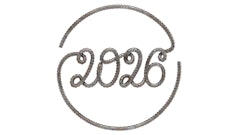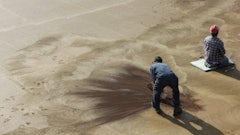
The yellow glow of sidewalks and patios in the dark of night may seem almost unnatural to some, but thanks to a new glowing aggregate product this effect is becoming more common in the concrete industry. Ambient Glow Technology's AGT aggregates are a non-toxic, glow-in-the dark aggregate. Mike Dagett, co-owner with his brother Brian Dagett of Dagett's Foundations located in Coxsackie, N.Y., is one contractor who has found success with the glowing aggregate, using it in several stamped patio projects.
The glowing aggregate is available in multiple colors and aggregate sizes, from sand to ½-inch stone. It can be used in several applications including decorative concrete, cement, terrazzo, stucco and floor epoxy trades.
Since learning about AGT aggregates, Dagett first experimented with several small slabs to understand the application process. Now it has become a regular service he offers his clients. When using AGT aggregate in stamped concrete, Dagett follows the standard steps of application.
On a recent patio project, Dagett first poured the slab putting a base color of cedar in the mix. In order to achieve a proper bond between the concrete and aggregate, Dagett uses a 4,000 pound mix and pours a 6 slump. To enhance the strength of the area, Dagett uses a fiber mesh, a wire mesh and small stones in the mix. After he poured and screed the slab, he cut it with rust and terracotta colors that were broadcast on top of the integrally colored slab.
Once the concrete reaches a specific consistency, the AGT aggregates can be placed. "It has to hit a certain consistency to stick the stone into the concrete so it won't sink," Mike Dagett says. "You have to get it [the concrete] to a certain consistency almost to the point where you have to dig the rock into the concrete itself." In this project, he used AGT ½-inch yellow aggregate that has an extreme yellow/green color at night and a pale yellow color during the day. Typically, Dagett hand places the aggregate sporadically throughout the area; however, the aggregate can be placed in designs if desired.
After placing the AGT aggregate in the concrete, Dagett applied a grey release over the surface and proceeded to stamp the area. According to Dagett, the release must be put down after the aggregate is placed otherwise the aggregate won't stick to the concrete. "After I stamped it with the grey release, I scrubbed most of the release off but it left a grey tint to it [AGT aggregate]," Dagett says. "I then went and used a charcoal antique to antique the joints."
The maintenance for stamped concrete with AGT follows standard procedure.
One characteristic that makes AGT aggregates desirable is the long-lasting glow it provides. Dagett compared the illumination of the AGT aggregates to outside solar lamps. "On a rainy day if you have solar lamps and there is hardly any sun, they won't turn on," he says. "It [AGT aggregate] glows for at least 12 hours, and on days without much sun it will still glow like that."
The unique effect of glowing aggregates doesn't come without some extra work. Contractors should be prepared that extra labor will be required when working on large concrete areas. "If you are going to do this you have to be prepared to work hard," Dagett says. "It is very labor intensive. If you are doing a patio you will need extra people just to place stone. "




















